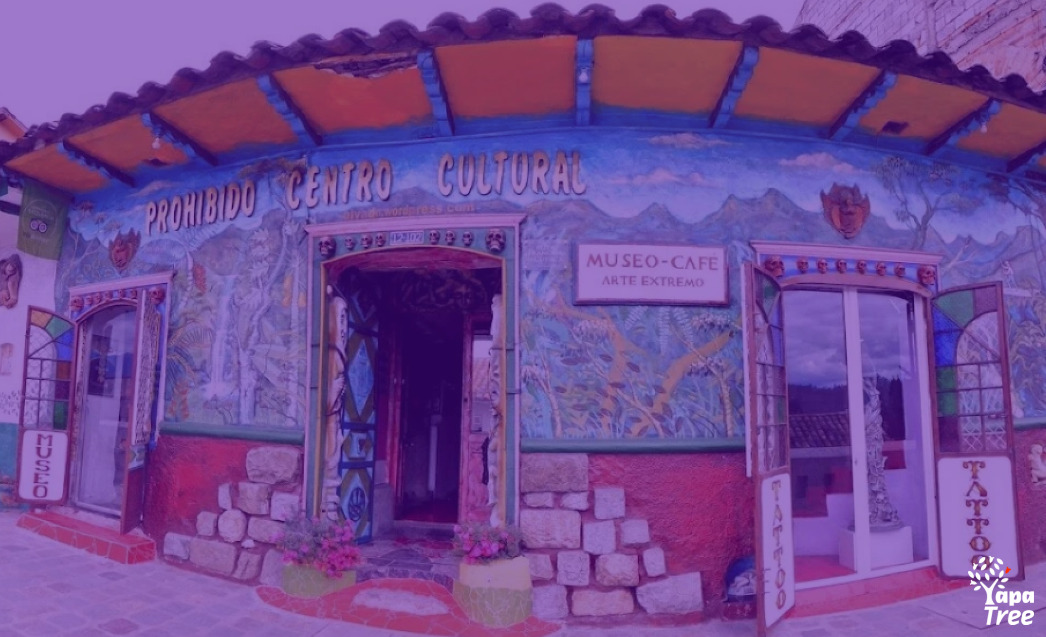Cuenca expats are familiar with its cobblestone streets, colonial architecture, and vibrant culture. But have you fully explored its artistic heart? Prohibido Centro Cultural, a unique art center, is a must-visit for anyone seeking to delve deeper into the city’s creative spirit. This sanctuary for alternative artistic expressions has been pushing the boundaries of creativity in Cuenca for over two decades. Prepare to be a bit shocked and disturbed in the best possible way when you visit. It will probably challenge your senses and your personal definition of art.
I originally entered the building with the assumption that it was a museum. It even says “Museo” at the entrance. That expectation caused some confusion for me. I would be inclined to call it a gallery of sorts rather than a museum. As I learned more about it, I found it quite interesting and will introduce you to a bit of its history, purpose, owner, and place in the Cuenca arts scene.

History
Prohibido Centro Cultural was founded in 1996 by Eduardo Moscoso, an artist from the Morona Santiago province. He left his job as an art professor to focus on his own work, but its controversial nature met a lot of resistance. Galleries either rejected it outright based on the content, or, if it showed, it was attacked by vandals. Moscoso had a dream of establishing a place where artists could freely exhibit their works without limits or societal constraints. He envisioned transforming a historic building in Cuenca’s El Vado neighborhood into a hub for the city’s artistic community. After careful restoration, the building was reborn as Prohibido Centro Cultural.

Vision To Reality
Moscoso’s goal of promoting unrestricted creativity and alternative art forms came to life in this space. The word Prohibido in the center’s name means “forbidden” in Spanish.
He has created a platform for both emerging and established artists with alternative themes. A place where any artistic vision, regardless of medium or content, is welcomed and protected.
The center’s mission is to provoke thought, foster conversations around controversial topics, and challenge societal norms through art and it did so for me. If I have any complaints about the presentation it’s the lack of explanation. This feeling might reflect my initial assumption that it was a museum, and art is often presented without explanation because it is up to the viewer to interpret the artwork. Personally, though, I would like easy access to background info on pieces in the various displays.
Challenging Norms Through Art
The museum showcases works that explore themes like sexuality, death, religion, and more, providing a platform for both local and international artists to display their art, engage with audiences, and drive conversations around subjects that are often considered taboo.
When you enter, be prepared for nudity, depictions of death in its various states, and similar themes. There are many masks that, based on my exposure to similar artwork in other cultures, I assume represent deities or demons. It would be easy to dismiss the displays as “kitschy” or to think they are simply intended to shock.

It is important to remember that the place was built as a haven for art from the fringes of society. As such, many themes are repeated because those themes were historically considered taboo, and some still are. Looking at a representation of a desiccated corpse, for instance, especially in this context, is not about the “gross-out” factor but, rather, it is an invitation to ponder mortality, because, in the end, we all end up in that state.

A Scholarly Thesis
I found a thesis about Prohibido Centro and its founder written by a university student, Francisco Miguel Quezada Bravo, entitled La estética neogótica en Cuenca: el caso del artista Eduardo Moscoso y el Prohibido Centro Cultural. In English, Neo-Gothic aesthetics in Cuenca: the case of the artist Eduardo Moscoso and the Forbidden Cultural Center.
The author dedicated the thesis to “all of those artists and philosophers who dealt with death as an aesthetic, ethical and religious object, necessary for life.” To me, this indicates that the artwork of Moscoso and others in the center, while often grim, is rooted in the celebration of life rather than a fascination with death.
Performance Art

I attended a show at the Prohibido Centro Cultural called Criaturas del Olvido (Creatures of Oblivion). While this article is about the place rather than this one performance, I do want to say the performance was excellent. It was a one-woman interpretive dance in which she played several characters. The woman, Sandra Gómez Navas, expressed a wide range of emotions through her expressions and movements. It was powerful, and if I get the chance to see her perform again, I will take it.
The segment I found most powerful was the first. Ms. Navas came out in a lycra body suit. There was a dress on the stage and a pair of shoes. She put on the dress, looked in a mirror (that wasn’t physically there), and took off the dress. She repeated this many times, putting the dress on and taking it off in a variety of ways. Sometimes she pulled it over her head, sometimes she lay on the stage and wriggled into or out of the dress. At one point, she threw the dress to the ground and stomped on it for a bit. With no words, she conveyed the emotions of dissatisfaction, frustration, and, ultimately, resignation.
While it might have represented something as “simple” as a woman preparing for a date and being unsatisfied with her wardrobe, the sense I got from it was a deeper story of body dysphoria, whether related to clothing or gender identity or thinking she should be slimmer or any of the other ways and degrees to which such dysphoria might present.
The space itself is best described as “intimate.” It has a small stage raised about ten inches. The front row of seats is about six feet from the edge of the stage. The seating itself consists of a sofa in the front row surrounded by folding chairs. It wasn’t the most comfortable of arrangements, but it was sufficient, and the quality of the performance made up for anything the seating lacked. The show cost seven dollars, and they passed out complimentary popcorn.
Schedule of Cabaret Performances
The Kabaret Prohibido has hosted performances of an extreme nature every Friday and Saturday evening at 7:30 since May 2023. Lucky for all of us thrill seekers there are some remaining performances in August.

Products and Services
These services and products are offered provided by the Prohibido Cultural Center:
- Room for artistic presentations (music, theater, conferences, workshops, video, etc.).
- Permanent Gallery (here you can see the works of the artist Eduardo Moscoso).
- Gastronomy and Cafeteria (daily menu is shown on their Facebook page. My favorite menu item is “Papás Prohibidas” Forbidden French Fries! Also, hot and cold drinks and other snacks.
- A variety of items to purchase like T-shirts also shown on their Facebook page.
- Kabaret Prohibido every Friday and Saturday Night.
- If you ask politely, you may just find yourself invited on a tour of the place in English or Spanish. It is a tourist destination after all.
Conclusion
Prohibido Centro Cultural showcases the power of art to challenge conventions, cultivate an open mindset, and bring people together. I think I agree that as morbid as the artwork appears on the surface, it actually celebrates life (the stranger parts or at least the last part) though in admittedly unconventional ways. For expats seeking to experience another side of creative Cuenca, I recommend a visit to Prohibido Centro Cultural. The center stands as a testament to the city’s enduring creative spirit.
Where to Find Prohibido Centro Cultural:
- Address: El Vado, La Condamine 12-102
- Google Maps
- Hours: Monday to Saturday 9 am – 9 pm, Sundays 9 am-2 pm
- WhatsApp: +593 99 514 1059
- Email: [email protected]
- Entrance fee: $2.00
- Webpage




















